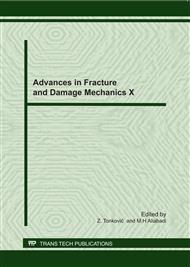p.498
p.502
p.507
p.511
p.521
p.525
p.529
p.533
p.537
Effect of Heat Treatment on Fracture during Bending in AA6016 Aluminium Alloy Sheets
Abstract:
The bending properties of high strength precipitation-hardening AA6016-type Al alloy thin sheets in pre-aged T4P temper state were studied in this work. Microstructural features like grain boundary particles distribution and volume fraction of the matrix strengthening phases were considered as factors controlling the mechanical properties and the fracture of this grade. Remarkable decrease in ductility, accompanied by severe deterioration of bendability occurred when coarse precipitates were found into the grain boundaries. The in-situ fracture sequence investigations as well as the post-failure surfaces observations indicated that grain boundary ductile fracture mechanisms were involved in the propagation of the cracks during bending. Heat treatment simulations were carried out and the results showed that the precise control of the technological parameters during production of these sheets is the key factor responsible for obtaining an appropriate combination of strength and bendability. Only by providing both, homogeneous distribution of the matrix strengthening phases and a favourable grain boundary structure, the severe and often contradictory requirements for the functional properties of these alloys can be successfully satisfied.
Info:
Periodical:
Pages:
521-524
Citation:
Online since:
September 2011
Price:
Сopyright:
© 2012 Trans Tech Publications Ltd. All Rights Reserved
Share:
Citation:


